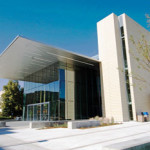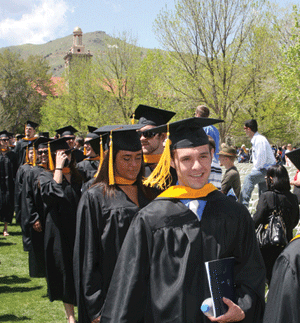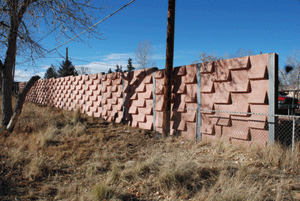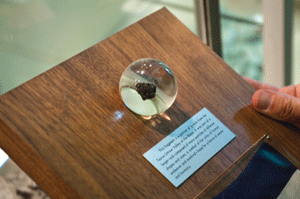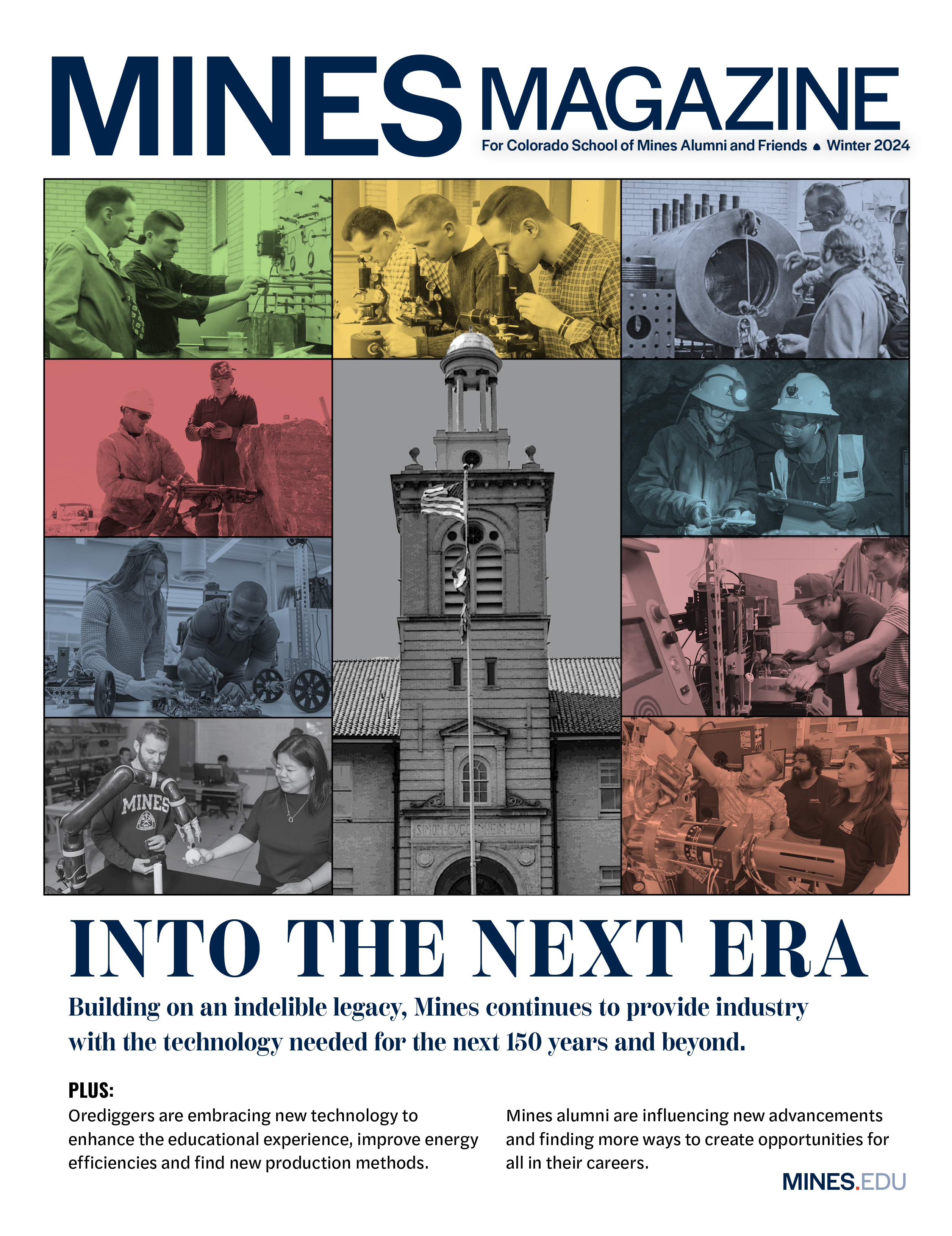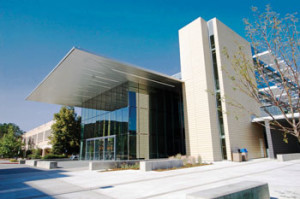
The entire campus benefits from the newly opened Marquez Hall, designated as the home of the Petroleum Engineering Department, but containing a wing with nearly 24,000 square feet of general classroom space.
�A record year in giving, highest-ever SAT scores for an incoming class, more research funding than in any previous year, on-campus recruiting reaching an all-time high, new athletic achievements, and an unprecedented pace of new construction: At the start of its 138th year, Mines can lay claim to a remarkable list of accomplishments.
One of the most tangible symbols of the school’s progress rises to the south of 16th Street, where the doors to Marquez Hall’s capacious glass atrium officially opened on September 28 during a ceremony attended by members of the school’s board of trustees, President Scoggins, lead donors Timothy ’80 and Bernadette Marquez (pronounced ‘Marcus’), several other major donors to the project, and members of the campus community.
It was the first time many of those attending the event had toured the Petroleum Engineering Department’s impressive new home, and most were struck by the architecture. The enormous glass walls that encase the atrium are suspended from a vast wing-like steel structure that floats overhead. The German terra cotta tiles that pave the floor continue uninterrupted under the walls, connecting the airy interior with the outdoors. Windows are everywhere in the building, lighting classrooms and framing the surrounding geology of Golden.
“It’s something all of our alumni and donors should take great pride in,” says Ramona Graves PhD ’82, head of the Petroleum Engineering Department and dean of the newly formed College of Earth Resource Sciences and Engineering. “Our department has always been one of the best. To have one of the most state-of-the-art buildings is only fitting.”
Designed by the architectural firm Bohlin Cywinski Jackson (known for designing the Apple store on 5th Avenue in New York and Pixar Animation Studios in Emeryville, Calif.), Marquez Hall and its high level of finish are a testament to the generosity of the Mines community. After an historic $10 million challenge grant from the Marquezes in 2005, more than 200 alumni, friends and corporate partners donated the remaining $17 million needed to complete the project.
“Alumni are appreciative of the education they got out here. Their companies love our graduates, they hire them,” says Graves. “Because of this we’ve been able to do some really great things.”
A 23,600-square-foot wing of Marquez Hall was financed through student fees and will be used by the campus as general classroom space. The rest of the 87,400-square-foot building has been paid for with private donations, making it the largest privately funded construction project on campus in decades.
Beauty and function
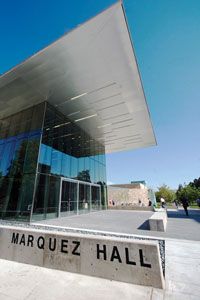 Marquez Hall is both user-friendly and energy efficient, earning LEED Silver certification. The 63,800 square feet of computer classrooms, laboratories, research centers and informal gathering areas feature desks with multiple plug-ins, group study areas equipped with large tables and frosted panes of glass for dry erase boards, and water bottle filling stations that dot the hallways.
Marquez Hall is both user-friendly and energy efficient, earning LEED Silver certification. The 63,800 square feet of computer classrooms, laboratories, research centers and informal gathering areas feature desks with multiple plug-ins, group study areas equipped with large tables and frosted panes of glass for dry erase boards, and water bottle filling stations that dot the hallways.
A key component of the building is the 3D visualization lab, a large room with theater-style seating, where students wear 3D glasses and virtually fly through petroleum reservoirs.
“Petroleum engineers work 1 mile, 5 miles, maybe even 10 miles into the ground. We can’t see where we work,” says Graves. “When students can actually plan a well, step back and see where it’s actually going to go, see how it’s actually going to intersect the geology, that’s huge.”
Watch a video and flip through a photo gallery about Marquez Hall.
Mines Achievements by the Numbers
#1. Students

The largest freshman class ever to whitewash the M hiked up Mount Zion on August 20; women comprise 28% of the incoming class.
This year’s incoming class is the largest in the school’s history. It was selected from a larger applicant pool than Mines has ever received (12,500) and the group’s average SAT score is higher than any preceding class. It also includes the largest number of women enrolled in a single semester, 298.
One of the most interesting statistics helped contribute to the large class size: Among those who received an offer to attend Mines, a considerably higher percentage accepted that offer compared to previous years. The goal was to enroll about the same number of students as last year (969), but this shift in behavior resulted in an influx of 1,066 new students.
Why the change? Positive press about the school, the high starting salaries of graduates, and research are all likely factors, as is the elevated interest in STEM fields seen nationwide. Expansion of scholarship programs and other economic factors are also likely to have contributed. But whatever the causes, Mines now has 4,000 undergraduate students enrolled, more than at any point in the school’s history.
1300: Average SAT score of this year’s incoming students, highest in school history
298: Number of women enrolling at Mines for the first time this fall, the previous record was 270
60%: New students who graduated in the top 10% of their high school class, the highest number on record
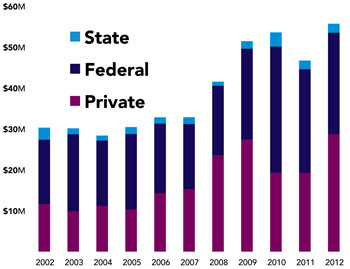
Mines research funding, 2002-2012
#2. Research
A new record was also set in 2012 for research funding. Commenting on the $55.7 million figure, up from $47.6 million in 2011. Vice President for Research and Technology Transfer John Poate says, “We are in the right place at the right time with a very talented faculty. We are winning major research awards from the federal agencies and industry across the whole spectrum of our research portfolio.” He points to water and the environment, unconventional oil and gas, solar energy, and strategic and critical minerals as areas that have gained national prominence. Poate adds, “Our long-lived industrial consortia and centers provide strong underpinnings for our research infrastructure.” And the numbers support these claims. In the last decade, research funding from private sources grew 146%, federal funding expanded by 47%, and state funding declined 25%.
#3. Philanthropy
At the end of a record-breaking year in giving, the Mines endowment stood at $204 million, double its 2002 value. The numbers tell the story:
$32.6M: Total value of all private gifts and commitments received during the 2011-2012 fiscal year, more than in any previous year
3,251 Total number of donors who gave to Mines during 2011-2012
34 New scholarships and fellowships created during 2011-2012
#4. Recruiting
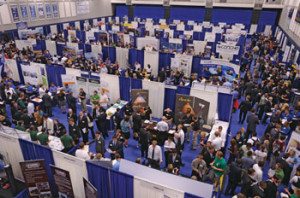 218: The number of companies who participated in Fall Career Day 2012, the school’s largest career fair ever (60 companies were on the waitlist).
218: The number of companies who participated in Fall Career Day 2012, the school’s largest career fair ever (60 companies were on the waitlist).
#5. Construction
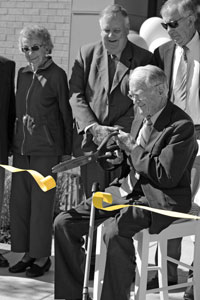
The W. Lloyd Wright Student Wellness Center officially opened on September 14.
In addition to the opening of Marquez Hall, the 10,192-square-foot W. Lloyd Wright Student Wellness Center was opened on September 14 with a ribbon-cutting ceremony. Named after the former Mines physician (pictured, seated), the $3.2 million facility caters to a variety of student wellness services, including medical and dental clinics, disability services, and personal and therapeutic counseling.
We added up the building space created by capital projects from the last two years (Marquez, Brown and Maple Halls, and the wellness center) and the tally comes to roughly a quarter of a million square feet, or 4.5 football fields. Yup, that’s another record.
And speaking of football
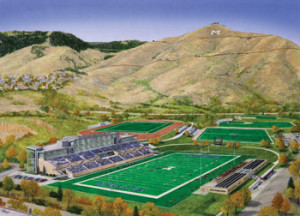
Completion of the Clear Creek Athletics Complex is targeted for fall 2014.
#6. Sports
The 2011-2012 school year saw the Orediggers climb to new heights: They won the Rocky Mountain Athletic Conference All-Sports Competition Cup for the first time, hosted the NCAA Division II men’s basketball tournament (also a first), and qualified for post-season play in an unprecedented 13 of 18 sports.
Mines athletics is also venturing into new territory with an ambitious fundraising initiative, a campaign to raise $21.3 million in private support for the Clear Creek Athletics Complex, which was kicked off with anonymous private commitments of nearly $9 million. The capstone project will benefit more than 70% of Mines student-athletes, as well as coaching staff and game-day spectators. It includes the Mines Athletics Center, which features:
- Marv Kay Stadium at Campbell Field, a 5,000-seat, ADA-compliant football stadium
- locker rooms for track and field/cross country and football
- training and sports medicine facilities, as well as office and event space
- facilities that accommodate intramural and club sports
Also included in the initiative are updates to the soccer field area (a press box, concessions and restroom facilities) and improved lighting for the track and field complex.
To learn more about Clear Creek Athletics Complex, visit giving.mines.edu/bigwin.

